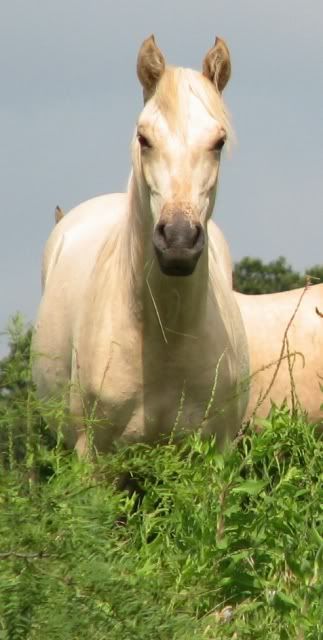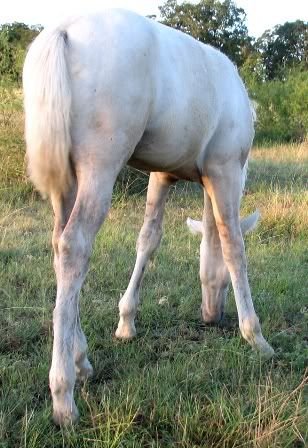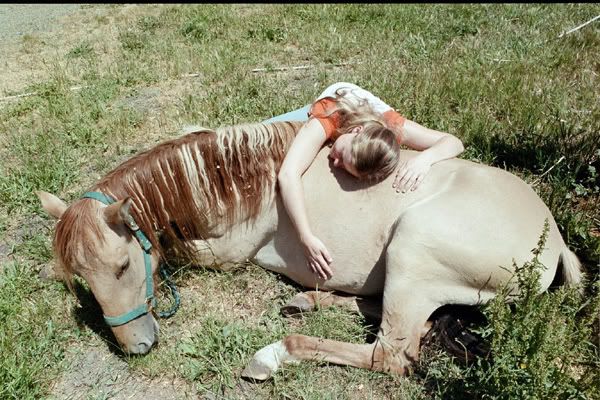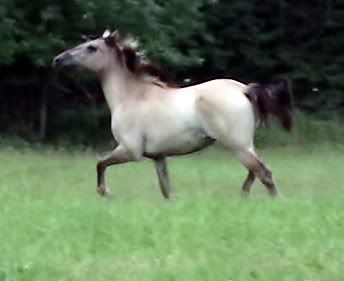|
|
Post by DianneC on Dec 18, 2009 21:20:53 GMT -5
I've never heard the term Isabella dun, it would be interesting to see if if you have a picture. Isabella are usually really light palominos, right? There is some modifier that determines light and dark in a shade. I call it extreme sooty for the dark, like Chinook. His face is much lighter than his cheeks, and so is under his tail. Funny thing is that he either threw really light (Mojito, Teanna, Bella) or really dark (Quil, Chick, Cruiser). The more medium grullas (Rio, Blue) were out of mares that had some sootiness.
|
|
|
|
Post by barbhorses on Dec 18, 2009 21:58:48 GMT -5
Here is are three isabella colored Lusitanos: donemorfarm.com/teteva.htmldonemorfarm.com/cremebrule.htmldonemorfarm.com/alabastro.htmlHere is what Kiger people I think normally refer to a "claybank". This horse to me looks like a buckskin that has greyed out, but the grey hasn't quite over taken all of the points yet. Which we all know that it takes a long time for grey to turn a horse totally "white" or mostly white. Although, if this horse is a buckskin that is greying, then there is a different color gene in there which of course is cream. donemorfarm.com/leche.html |
|
|
|
Post by Michelle Clarke on Dec 18, 2009 22:30:23 GMT -5
Those Lusitanos are double dilutes, not isabella palaminos...Dianne is right, isabellas are light palaminos - have dark eyes and dark skin. An "isabella" dun, then, would have blue eyes and light skin, according to your idea. Our colt, Gringo, is double dilute, plus dun but I would not say he is palamino because he is black based. Our filly, Amada, shows both the isabella color plus dun:   |
|
|
|
Post by barbhorses on Dec 18, 2009 23:31:37 GMT -5
hmmm then I think there is a variety of definitions on the color. The owner of the site has all three of those Lusitanos listed as Isabellas. I also saw a light palomino QH listed as an Isabella on another site.
I will shoot an email to Dr. Sponenberg to see what a real isabella is because right now I am confused! I don't know too much about these light colored horses.
|
|
|
|
Post by Michelle Clarke on Dec 19, 2009 8:34:54 GMT -5
Queen Isabella orginally sent "golden colored horses" to the "new spain" which was Mexico. She sent one stallion and five mares I belive. They then came up through Texas into the new world. I am not sure how it got to be that now they refer to such a light colored horse, but many folks have different definitions. In an old book I have from the 17th century, they are refered to as a palamino that is almost white colored.
|
|
|
|
Post by sbutter on Oct 29, 2010 17:29:03 GMT -5
I asked barbhorses if she could send me a copy of what the results showed in detail, since I have never personally seen what color results look like. I met a Kiger that was bred by Rick Littleton (she was by Silverado) down in Long Beach some years ago. She was sold as a claybank, but she was clearly greying out. This is what a traditional claybank looks like. And yes, it is because it looks like they rolled in clay. This is a Sulphur mare (Sampson x Blossom).  I had this very creamy looking mare (Sulphur's Arista) tested and she came up: ee (homozygous red) aa (black base coat) nn (negative for cream) nn (silver) nn (pearl). What makes her coat look so pale? I have no idea. www.youtube.com/watch?v=4_Nl-YeURNAGuess it is the same modifier that makes this grulla look silver! Yes, I know he looks funny, I think the Sulphur way of being excited makes them look like a deer! lol The Sulphur cannot flag their tails like most other horses.  ------------------------------------- Date Received: 7/10/2009 Horse Name: Sulphur's Arista Breed: Spanish Sulphur Red Factor: ee Agouti: aa Cream: nn Silver: nn Pearl: nn Result Guide: Red Factor ee----Only the red factor detected. The horse tested homozygous for red pigment. The basic color is chestnut or sorrel, but depending on genes at other color loci, the horse could be red dun, palomino, cremello, gray or white. Ee----Both black and red factors detected. The horse tested heterozygous for the red factor. It can transmit either E or e to its offspring. The basic color of the horse will be black, bay or brown, but depending on genes at other color loci, the horse may be buckskin, zebra dun, grullo, perlino, gray, or white. EE----Only the black factor detected. The horse tested homozygous for black pigment. It cannot have red foals regardless of the color of the mate. The basic color of the horse will be black, bay or brown, but depending on genes at other color loci, the horse may be buckskin, zebra dun, grullo, perlino, gray or white. Agouti aa---Only recessive allele detected. Black pigment distributed uniformly. The basic color of the horse will be black in the absence of other modifying genes. Aa---Horse tested Heterozygous for Agouti. Black pigment distributed in point pattern. The basic color of the horse will be bay or brown in the absence of other modifying genes. AA---Only dominant allele detected. Black pigment distributed in point pattern. The basic color of the horse will be bay or brown in the absence of other modifying genes. Cream Dilution CrCr---Double dilute. Horse tested Homozygous for Cream Dilution (Two copies of the Cream allele). Chestnut is diluted to cremello; bay is diluted to perlino and black is diluted to smoky cream. These colors can be further modified by the actions of other genes. nCr---Dilute. Horse tested Heterozygous for Cream Dilution (One copy of the Cream allele). Chestnut is diluted to palomino; bay is diluted to buckskin and black is diluted to smoky black. These colors can be further modified by the actions of other genes. nn---Non-dilute. Horse tested negative for Cream Dilution. Basic colors are chestnut, bay, black or brown in the absence of other modifying genes. Silver Dilution ZZ---Horse tested Homozygous for Silver Dilution (Two copies of the Silver allele detected). Black-based horses will be chocolate with flaxen mane and tail. Bay-based horses will have pigment on lower legs lightened and flaxen mane and tail. No effect on chestnut color. nZ---Horse tested Heterozygous for Silver Dilution (One copy of the Silver allele detected). Black-based horses will be chocolate with flaxen mane and tail. Bay-based horses will have pigment on lower legs lightened and flaxen mane and tail. No effect on chestnut color. nn---Horse tested negative for Silver Dilution. |
|
|
|
Post by barbhorses on Oct 29, 2010 18:37:13 GMT -5
It's no worries. I know that people would prefer to see the results in the direct form from the lab, but obviously Sarah was not able to put it in that format on the board either.
If anyone wants the email that I got from the lab forwarded to them as well to be able to see it in the format that the lab sent it to me then I have no problems (obviously) to forward the email.
|
|
|
|
Post by DianneC on Oct 29, 2010 19:29:44 GMT -5
I notice that the UDAvis coat color site is using a new way to write for the creme gene. Its very confusing as I'm used to other colors using a capital letter for having the gene and a small letter to show not having it, i.e. E for having black and e for not having it. It used to be Cr for having creme and cr for not. Now they are writing Ccr for having it and C for not. Here is the site www.vgl.ucdavis.edu/services/coatcolor.php#genecUsually people just write about what a horse has and how many genes it has of that color. If its not grey or creme or paint it isn't written unless there is a question. So a grulla that was homozygous for black and had one dun gene would be simply written as EEDd. A red dun with two dun genes would be written eeDD. There are some good sites out there and its fun play with color. |
|
kigerkrazy
New Born
 True freedom is found only on the back of a good horse
True freedom is found only on the back of a good horse
Posts: 44
|
Post by kigerkrazy on Oct 30, 2010 1:00:46 GMT -5
This thread has been a great read. I'm still trying to get the hang of how the color genes work. I'm still a little lost on what causes dappling?
|
|
|
|
Post by DianneC on Oct 30, 2010 10:14:42 GMT -5
Dappling can have a couple of different causes. The first is a light dappling on a horse that doesn't always have it, often seen in summer and it is taken to mean good health. Other causes are coat color related, a dark horse turning grey, a sooty gene (darkens the coat color) often seen on dark buckskins and the silver gene which produces a lovely silver mane and often has a dark dappled coat to go with it.
All horse color starts with a base of either black or red, everything else modifies that color.
|
|
kigerkrazy
New Born
 True freedom is found only on the back of a good horse
True freedom is found only on the back of a good horse
Posts: 44
|
Post by kigerkrazy on Oct 30, 2010 21:22:10 GMT -5
Thanks Dianne. Interesting stuff.
|
|